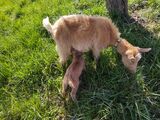The early years of Golden and British Guernseys in the UK and US

History of the Guernsey Goat Origin The Golden Guernsey goat originated on the Channel Islands (British Crown Dependencies) in the English Channel. These islands were ports of call for sailing ships, sailing out of the Mediterranean and headed for the Cornish tin mines since long before the birth of Christ. These ships often carried goats and other animals, trading them and acquiring others all along their routes and no doubt continued this on the Channel Islands. Thus the ancestry of... Full article >
|

In a previous blog post, we covered the differences between the A1 and A2 beta-casein proteins in milk. In this article, we’ll look closely at the alpha s1-casein protein, which has been identified as one of the major cow milk allergens, and how goat milk may be the answer to your milk-related woes. To refresh our memories, above is a basic diagram that shows the different proteins in cow’s milk. [If you need a larger image, right click on it and choose "Open image in new tab" to see a full s... Full article >
|

As consumers become more health-minded, they’re paying increasingly more attention to the ingredient and nutritional facts of the products they purchase—and put in their bodies. Thanks to organized educational efforts and mandatory nutritional food labels, this has become easier for consumers. Goat milk has well established nutritional and health benefits and any online search will turn up a number of reports and articles attesting to its advantages. However, a lot of that information lacks cont... Full article >
|

As you may or may not already be aware, there are many different kinds of milk—from cows, goats, and sheep; and there’s also plant- and nut-based milk like almond, soy, rice, and hemp milk. One of our favorite things about goat milk is its uniqueness, and one of the things that make it so unique is its chemical makeup. The difference between each kind of milk’s chemical composition usually boils down to its point of origin. However, did you know that there are some other, less obvious disti... Full article >
|

(BeWellBuzz) Anthropologists, archaeologists and geneticists conjecture that dairy in the diet goes back as far as 7,500-8,000 years. A study examining “The Ancient Roots of Milk Consumption,” with a specific interest in lactose tolerance, identified a population that began to “raise cattle and consume milk products more than 5,000 years ago.”[1] Probably also about 4-5,000 years ago it was written that Jehovah, The God of the Jews, promised Israel a land flowing with milk and honey. An old Jewi... Full article >
|